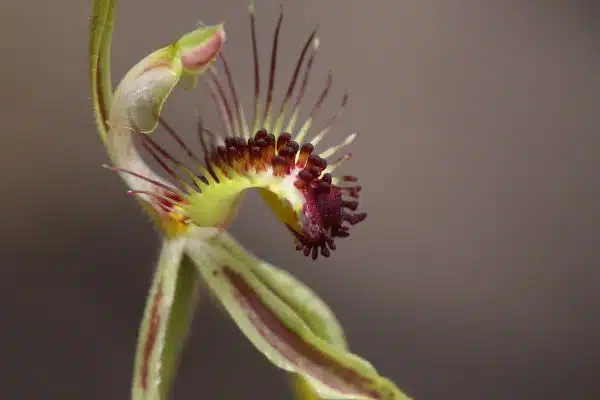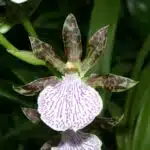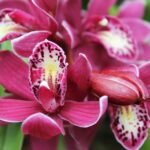Orchids are a popular and coveted plant species that can be grown in various ways. One of the most unique and intriguing ways to grow orchids is by mounting them. Mounted orchids are a beautiful addition to any indoor or outdoor space, as they display their vibrant blooms in an artistic and natural way.
Mounting orchids may seem like a daunting task for those who have never done it before, but with proper guidance and care, it can be a rewarding experience. In this article, we will explore the basics of how to grow mounted orchids, including the best materials to use, suitable locations for mounting, watering and fertilizing techniques, and tips for addressing any issues that may arise during the growth process. Whether you are a seasoned horticulturalist or new to gardening altogether, this guide will provide valuable insights on how to cultivate healthy and thriving mounted orchids.
Understanding The Basics Of Orchid Care
Orchid potting and soil composition are essential aspects of orchid care. Orchids require a specific type of soil to grow and thrive. The ideal potting mix should be able to hold moisture without becoming waterlogged, provide adequate drainage, and allow air circulation around the roots. Most orchids grow well in bark-based mixes, which are made up of different sizes of bark chips that create air pockets, allowing the roots to breathe.
Orchid lighting is another crucial factor in their growth and development. Understanding light requirements is critical for healthy plant growth. Different species of orchids have varying degrees of light requirements. Some prefer bright but indirect light, while others need direct sunlight. It’s essential to know how much sun exposure your orchid needs to prevent it from getting burned or not getting enough light.
In summary, proper orchid care begins with understanding the basics of potting and soil composition and lighting requirements. Orchids require a specific type of soil mix that can hold moisture without becoming waterlogged while providing adequate drainage and air circulation around the roots. Understanding their lighting requirements is also crucial for healthy plant growth as different species have varying degrees of light needs. Knowing these basics will help you choose the right orchid species for mounting in the subsequent section without any transition words like ‘in conclusion’ or ‘finally.’
Choosing The Right Orchid Species For Mounting
- When selecting an orchid species for mounting, climate is an important factor to consider, as some species may be better suited to warmer or cooler climates.
- Mounted orchids need to be exposed to bright, indirect sunlight in order to thrive.
- Humidity should be kept above 50% for optimal orchid growth, and the potting media should be light and well-draining.
- Watering should be done weekly, allowing the root mass to dry out between each session.
- Fertilizer should be used every two weeks in order to provide the necessary nutrients for healthy growth.
- Air circulation should be provided to the mounted orchid to prevent disease, while pruning, mounting, flowering and repotting should also be done at the appropriate times.
Climate
In order to grow mounted orchids successfully, it is essential to choose the right species that can thrive in the ideal climate. Certain orchid species are better suited for mounting than others due to their ability to adapt to varying conditions. When considering the ideal climate for orchid growth, it is important to take into account factors such as temperature, humidity and light.
Orchid mounting materials can greatly impact the ability of a plant to adapt to its environment. Materials such as cork bark, tree fern fiber or slabs of wood provide a naturalistic setting for orchids to grow and establish themselves. These materials are porous and allow for air circulation around the roots while also retaining moisture, which is crucial for proper growth.
The ideal climate for orchid growth varies depending on the species being grown. In general, most orchids prefer temperatures between 60-80 degrees Fahrenheit with humidity levels ranging from 40-70%. Light requirements also vary depending on the species, with some requiring direct sunlight while others prefer indirect or filtered light. It is important to research each specific species before choosing which orchids to mount in order to ensure they will thrive in their environment.
Light
When choosing the right orchid species for mounting, one important factor to consider is the type of light required for optimal growth. Different orchid species have varying light requirements, which can affect their ability to adapt and thrive in a mounted environment. Some orchids require direct sunlight for several hours each day, while others prefer filtered or indirect light.
There are three main types of light that can be provided for mounted orchids: full sun, partial shade, and full shade. Full sun exposure is appropriate for some orchid species, but it is important to monitor the duration of exposure as too much direct sunlight can lead to burning or drying out of leaves and roots. Partial shade, on the other hand, provides enough light for most mounted orchids to grow and bloom without overexposure. Full shade is ideal for certain orchid species that require low levels of light.
In addition to determining the appropriate type of light, it is also important to consider the duration of light exposure when selecting an orchid species for mounting. Most mounted orchids require approximately 10-12 hours of daylight each day in order to thrive. This can be achieved through natural sunlight or with artificial lighting sources such as LED grow lights. By taking into account both the type and duration of light required by each specific orchid species, horticulturalists and botanists can select the best-suited plants for mounting and ensure their long-term success in a variety of environments.
Humidity
Choosing the right orchid species for mounting requires considering various factors, including light requirements. Another crucial factor to consider is humidity. Orchids are tropical plants that thrive in high humidity environments, and a lack of moisture can cause stress or damage to the plant. Therefore, it is essential to choose an orchid species that can adapt well to changes in humidity levels.
Humidity fluctuations can be challenging to manage, especially when growing orchids indoors. Low humidity levels can be detrimental to orchids, causing dryness and leaf drop. In contrast, high humidity levels can promote fungal growth and attract pests such as mites and scale insects. DIY humidity solutions such as misting or using a humidifier can help maintain a consistent level of moisture around your mounted orchids.
Certain orchid species require higher levels of humidity than others, so it is important to select an appropriate species for mounting based on your environment’s average relative humidity. Additionally, it is essential to monitor the conditions regularly and adjust any DIY humidity solutions accordingly. By choosing the right orchid species and managing humidity fluctuations effectively, you can ensure the long-term success of your mounted orchids in various environments.
Preparing The Mounting Materials
To grow mounted orchids, it is crucial to prepare the right mounting materials. There are various types of mounts available, but the most common ones include cork, tree fern fiber, and hardwood slabs. Cork provides excellent aeration and moisture retention, while tree fern fiber is lightweight and durable. Hardwood slabs are sturdy and long-lasting, making them ideal for larger species of orchids.
Once you have chosen your mount, the next step is to decorate it. This not only adds visual appeal but also helps to retain moisture around the orchid’s roots. Decorative items such as sphagnum moss, coconut husk fibers, or even dried leaves can be used to wrap around the mount. It would help if you made sure that these items are moistened before wrapping them around the mount.
Decorating your mount also involves creating a suitable attachment point for your orchid. You can use wire or fishing line to create a loop at the top of your mount so that you can hang your orchid up. Alternatively, you can drill holes into your hardwood slab or insert hooks into your cork or tree fern fiber to secure your orchid in place. The next section will cover how to securely attach your orchid to its mount without damaging its roots.
Securing The Orchid To The Mount
Securing the Orchid to the Mount is a crucial step in growing mounted orchids. The type of mount used will depend on personal preference and the specific needs of the orchid. Some common types of mounts include bark, cork, and tree fern.
When securing the orchid to the mount, it’s important to consider DIY mounting options. This can include using fishing line or wire to tie the orchid onto the mount. It’s essential not to wrap wire too tightly around the stem or roots as it can cause damage or restrict growth.
Another option is gluing the orchid onto the mount. A waterproof adhesive such as silicone or hot glue can be used to secure the plant without causing harm. However, it’s important not to apply too much glue as it can block air circulation and lead to rotting.
To ensure that your mounted orchid thrives, selecting the ideal location for your orchid is necessary. This will depend on factors such as light requirements, humidity levels, and temperature preferences. In the next section, we will discuss how to select an optimal location for your mounted orchid based on these factors.
Selecting The Ideal Location For Your Mounted Orchid
Mounted orchids require specific climatic conditions to reach their full potential. Light requirements should be taken into consideration when selecting the ideal location, as these plants require bright, indirect light. Humidity is another important factor to consider when locating your mounted orchid, as high humidity is essential for their growth. Air circulation should also be taken into account, as mountings should be placed in locations with good air movement to prevent stagnation of moisture. The combination of light, humidity, and air circulation can help ensure the plant’s maximum health. Proper selection of the location for your mounted orchid is crucial for its successful growth.
Light Requirements
As orchid enthusiasts, we all know that the beautiful blooms of these plants are heavily reliant on the right amount and quality of light. It is crucial to determine whether natural or artificial light sources will work best for your mounted orchids. Natural light is always preferred, but it may not always be available. Thus, one must choose the right artificial lighting system that can mimic the intensity and spectrum of sunlight.
When it comes to growing mounted orchids, adjusting light levels according to seasonal changes is essential. For instance, during winter months when days are shorter and sunlight is weaker, more artificial light may be required to maintain optimal growth conditions. Similarly, during summer months when natural sunlight is much stronger, a little bit of shade may be necessary to prevent leaf scorching.
In conclusion, determining the best lighting system for your mounted orchid depends on many factors such as availability of natural light and seasonal changes. Orchid enthusiasts need to pay close attention to their plant’s response to different light levels and make adjustments accordingly. With proper care and attention, your mounted orchids will bloom beautifully for years to come!
Humidity
Maintaining the right humidity level is another crucial factor in selecting the ideal location for your mounted orchids. These plants are native to tropical regions with high humidity levels, making it imperative to provide them with adequate moisture. Inadequate moisture often leads to stunted growth, yellowing leaves, and wilting flowers.
One way to increase humidity levels is by using a DIY humidifier. This can be achieved by placing a tray filled with water near your mounted orchids or hanging damp towels around them. Another option is to use natural humidity sources such as pebble trays or gravel beds filled with water. These methods help maintain a consistent level of moisture around the plant’s roots and foliage.
It’s important to note that excessive humidity can also harm your orchids by promoting fungal growth and root rot. Therefore, it’s crucial to monitor humidity levels regularly and adjust accordingly based on the plant’s response. By providing optimal humidity levels for your mounted orchids, you ensure healthy growth and vibrant blooms that will add beauty to any space they inhabit.
Air Circulation
Optimizing air circulation is an essential factor to consider when selecting the ideal location for your mounted orchids. Adequate air movement helps prevent mold growth and promotes healthy plant growth. Mounted orchids require a consistent flow of fresh air to mimic their natural habitat in tropical regions.
Improving air circulation can be achieved by placing a small fan near your mounted orchids or opening windows to allow for natural ventilation. It’s also crucial to avoid overcrowding plants as this restricts airflow and increases the risk of fungal diseases. Moreover, pruning dead leaves and flowers regularly prevents decay and improves overall plant health.
Preventing mold growth is critical when growing mounted orchids indoors. Mold thrives in stagnant, humid environments with poor air circulation, making it essential to maintain optimal humidity levels while promoting adequate airflow around the plant’s roots and foliage. By providing proper air circulation, you ensure that your mounted orchids thrive in a healthy environment conducive to vibrant blooms and lush foliage.
Monitoring Temperature And Humidity Levels
After selecting the ideal location for your mounted orchid, it is important to monitor the temperature and humidity levels to ensure optimal conditions for growth. Orchids thrive in environments with high humidity and temperatures ranging from 60-80°F. It is essential to avoid exposing your mounted orchid to extreme temperatures, as this can affect its growth and development.
Temperature control is a crucial aspect of growing mounted orchids. During the day, temperatures should be kept between 70-80°F, while at night they should be allowed to drop no lower than 60°F. To maintain these temperature ranges, you can use a thermostat or place your orchid in an area with adequate ventilation that receives indirect sunlight. In addition to temperature control, maintaining proper humidity levels is also important for the healthy growth of your plant.
In order to maintain optimal conditions for your mounted orchid, it is recommended that you regularly check the temperature and humidity levels using a thermometer and hygrometer. If necessary, you can adjust the environment by using humidifiers or placing trays of water near your plant. By providing your orchid with the right environment, you’ll help it thrive and bloom into a beautiful display of nature’s magnificence. Next up, we’ll discuss watering techniques for mounted orchids to further support their growth and development.
Watering Techniques For Mounted Orchids
Watering your mounted orchids can be a delicate process as they require just the right amount of moisture to thrive. The frequency of watering depends on several factors, such as the type of orchid, the environment it is in, and its size. Generally speaking, you should water your mounted orchids once or twice a week during warm weather and less frequently during colder seasons.
Misting is another technique that can benefit your mounted orchids. It involves spraying fine droplets of water onto the plant’s leaves and roots using a spray bottle. Misting helps maintain the humidity level around the orchid’s roots, which is crucial for its growth. However, misting alone is not sufficient to keep your mounted orchids hydrated; you should still water them thoroughly.
To ensure proper watering techniques for your mounted orchids, make sure you do not overwater or underwater them. Overwatering can cause root rot and other diseases that could kill your plant, while underwatering can lead to dehydration and stunted growth. Always check the soil’s moisture levels before watering or misting and adjust accordingly. By following these techniques, you’ll be able to grow healthy and vibrant mounted orchids in no time.
Transition:
Now that you know how to properly water your mounted orchid let’s move on to fertilizing techniques that will help promote healthy growth!
Fertilizing Your Mounted Orchid
Watering techniques are critical in keeping your mounted orchid healthy and thriving. However, it is not enough to rely on water alone. To ensure optimal growth and flowering of your orchid, fertilization is also necessary. This section will delve into the frequency of fertilization and the types of fertilizers that are best suited for your mounted orchid.
Frequency of fertilization depends on the type of orchid you have and its stage of growth. Generally, during active growth periods, such as spring and summer, you should fertilize your orchid every two weeks. During dormancy or resting periods, such as fall and winter, you can reduce fertilization to once a month or even less frequently. Over-fertilizing can lead to salt buildup in the potting medium, causing damage to the roots.
When it comes to choosing a fertilizer for your mounted orchid, there are many options available on the market. It is important to choose a fertilizer that is balanced in its nutrient content with equal amounts of nitrogen (N), phosphorus (P), and potassium (K). Fertilizers specifically formulated for epiphytic plants like orchids are often preferred since they contain micronutrients essential for healthy growth. Liquid fertilizers are also recommended since they are easily absorbed by the plant.
As important as watering and fertilizing may be to maintaining healthy orchids, pruning and grooming your plant is also crucial. In the next section, we will discuss how proper pruning techniques can help control size and shape while promoting new blooms. We will also explore tips on grooming such as cleaning leaves, removing dead flowers, and inspecting for pests or diseases that may hinder growth.
Pruning And Grooming Your Orchid
- Regular cleaning of orchid leaves is necessary to ensure they are free of dust and dirt, and to prevent the spread of infections.
- Pruning stems should be done to remove any dead or damaged parts of the plant, as well as to encourage healthy growth.
- Repotting should be done annually or when the orchid has outgrown its current container.
- When repotting, it is important to use a potting medium that is designed for orchids and to be sure not to damage the roots of the plant.
- Removing old, dead roots from the plant is necessary to provide room for new growth, along with any excess soil.
- After repotting, it is important to provide the orchid with plenty of light and water to facilitate healthy growth.
Cleaning The Leaves
When it comes to growing mounted orchids, one of the most important aspects of pruning and grooming is leaf maintenance. The leaves of your orchid are not only responsible for photosynthesis, but they also play a crucial role in the overall health and appearance of your plant. Proper leaf maintenance involves regular cleaning to prevent discoloration and other issues that can negatively impact the growth of your orchid.
One common problem with orchid leaves is discoloration. This can occur due to a variety of factors, including pests, disease, or simply aging. In order to prevent discoloration from becoming a bigger issue, it’s important to clean your orchid’s leaves on a regular basis. Use a soft cloth or cotton swab dipped in water to gently wipe down each leaf, taking care not to damage the delicate tissue. This will remove any dust or debris that may be contributing to discoloration.
In addition to preventing discoloration, regular leaf maintenance can help keep your mounted orchids looking their best. By keeping the leaves free from dust and debris, you can help ensure that your plant remains healthy and vibrant. With proper care and attention paid to leaf maintenance, you can enjoy beautiful blooms and healthy growth from your mounted orchids for years to come.
Pruning Stems
Proper pruning and grooming techniques are crucial for the overall health and growth of your orchid plant. Apart from leaf maintenance, stem maintenance is equally important to ensure the proper development of your mounted orchids. Trimming techniques should be carried out with care to avoid damaging the delicate tissue of the stems.
Stems can become overgrown or damaged due to a variety of factors such as pests, disease, or improper care. Regular maintenance through trimming helps promote new growth and ensures that your orchid remains healthy. When trimming stems, it is important to use clean and sharp tools to avoid causing damage or introducing infection into the plant.
Proper pruning techniques involve identifying which stems need trimming. Dead or diseased stems should be removed entirely, while overgrown stems can be trimmed back in stages until they reach an appropriate length. Trimming should be done just above a node on the stem where new growth will emerge. With careful attention paid to stem maintenance, you can help ensure that your mounted orchids remain healthy and produce beautiful blooms for years to come.
Repotting
Proper pruning and grooming techniques are essential for maintaining the health and beauty of your orchid plant. However, there comes a time when repotting is necessary to ensure optimal growth and development. Repotting should be done every one to two years, depending on the size of the pot and the growth rate of the orchid.
When repotting, it is crucial to select an appropriate potting mix that provides adequate drainage and aeration for your orchid’s roots. Common mistakes to avoid during repotting include damaging the delicate roots, using a pot that is too large, or over-watering after repotting. Alternative mounting options can also be used for some species of orchids.
Decorating your mounted orchid can add an extra touch of beauty to your display. Adding accents such as moss or decorative stones can enhance the aesthetic appeal of your orchid while also providing additional support for its roots. Creating a display arrangement with other plants or accessories can further highlight the natural beauty of your mounted orchid. By following proper pruning and grooming techniques and periodically repotting your orchid, you can ensure its continued growth and vibrancy for years to come.
Dealing With Pests And Diseases
Prevention is always the best way to avoid pests and diseases in your mounted orchids. One way to prevent infestations is by keeping a clean environment. Regularly cleaning the area around the orchid can help reduce the risk of attracting insects that may damage it. Another preventative measure is to inspect your orchid regularly for any signs of damage or stress, as these can make it more susceptible to pests and diseases.
If you do find yourself dealing with a pest or disease problem, there are natural remedies available that can help. One option is using neem oil, which is an effective insecticide and fungicide. You can mix neem oil with water and spray it on your orchid to control pests or fungi. Another natural remedy is using diluted dish soap solution as a pesticide for insects such as mites and aphids.
Preventing pest and disease problems in your mounted orchids requires consistent effort, but it’s worth it to keep your plants healthy and thriving. By implementing preventative measures such as keeping a clean environment and regularly inspecting your orchids, you can reduce the risk of infestation. If you do encounter issues, natural remedies like neem oil or diluted dish soap solution can be effective in controlling pests and diseases. In the next section, we will discuss how to repot your mounted orchid for optimal growth.
Repotting Your Mounted Orchid
Mounting orchids can be a rewarding experience for any plant enthusiast. Although it may seem daunting at first, repotting your mounted orchid is essential to keep it healthy and thriving. The process of repotting may vary depending on the type of orchid and its growth stage, but there are some general repotting techniques that can be followed.
Firstly, before repotting your mounted orchid, ensure that it has been adequately watered to avoid transplant shock. It is best to wait until the orchid has finished blooming before moving it to a new pot. When removing the orchid from its current mount, handle it gently so as not to damage its roots or leaves. Once removed, trim away any damaged or dead roots using sterilized scissors.
Next, prepare a new mount for your orchid by selecting a suitable material such as cork bark, tree fern fiber or driftwood. Before mounting the orchid, soak the new mount in water overnight to ensure that it is thoroughly hydrated. Then attach the orchid’s roots firmly onto the mount using fishing line or wire ties. Finally, place your newly potted orchid in an area with bright but indirect light and maintain proper watering habits.
Maintenance tips:
- Ensure that your mounted orchids are receiving adequate airflow.
- Check regularly for pests such as spider mites or mealybugs.
- Fertilize your mounted orchids with a balanced fertilizer every two weeks during their active growing season.
In conclusion, repotting your mounted orchids requires patience and attention to detail; however, following these simple steps can help you achieve healthy and thriving plants. If you encounter issues with your newly potted plants such as wilting or yellowing leaves, don’t panic! Troubleshooting common issues is an integral part of plant care and will be covered in the subsequent section.
Troubleshooting Common Issues
Light is an essential factor for growing mounted orchids. Insufficient water, improper fertilization and inadequate temperature can lead to stunted growth or death. Pest infestations, over-potting, root rot and poor air flow can also be detrimental to the health of orchids. Humidity, nutrients and soil type should be closely monitored and regularly adjusted to ensure optimal growing conditions. Improper watering, inadequate drainage and overcrowding can also lead to stunted growth or death. Shock due to sudden changes in environment should also be avoided.
Too Little Light
Orchids are known for their vibrant colors and intricate shapes, making them an attractive addition to any home. However, growing orchids can be tricky, especially when it comes to providing adequate lighting. Understanding the lighting requirements of mounted orchids is key to ensuring healthy growth and blooming.
Mounted orchids require bright but filtered light to thrive. Direct sunlight can cause sunburn on the delicate leaves and flowers, while too little light can prevent proper photosynthesis, leading to stunted growth and lack of blooms. It’s important to position mounted orchids in a location that receives bright, indirect light for several hours a day.
To prevent sunburn on mounted orchids, it’s recommended to use a sheer curtain or shade cloth to filter the direct sunlight. If natural light is not sufficient, artificial lighting can be used as a supplement. LED grow lights are a popular choice among orchid growers due to their energy efficiency and customizable spectrum options. Providing consistent and appropriate lighting will help ensure healthy growth and blooming for your mounted orchids.
In conclusion, understanding the lighting requirements of mounted orchids is essential for successful cultivation. Too little light can hinder growth while direct sunlight can cause sunburn. By providing bright but filtered light through natural or artificial means, you can help your mounted orchids thrive and produce stunning blooms year-round.
Insufficient Water
Maintaining proper watering frequency is crucial in the healthy growth of mounted orchids. Insufficient water can lead to dehydration, which can impede photosynthesis and eventually stunt plant growth. Orchid growers must be mindful of signs of dehydration with their mounted orchids, such as shriveled or yellowing leaves, dry potting mix, and root damage.
To prevent dehydration in mounted orchids, it’s essential to establish a consistent watering routine. Generally, mounted orchids require more frequent watering than potted varieties due to their exposed roots’ increased exposure to air. Watering should be done when the potting mix or mounting material has dried out completely. To ensure adequate hydration, some growers opt for a soak-and-dry method where the plant is submerged in water until thoroughly saturated, then left to dry out before being watered again.
When faced with a dehydrated mounted orchid, immediate action must be taken to revive it. Soaking the entire plant in room temperature water for several hours can rehydrate the roots and leaves effectively. It’s important not to overwater the plant or use cold water as this could further stress it. With enough patience and proper care, even severely dehydrated mounted orchids can recover and eventually produce stunning blooms for years to come.
Improper Fertilization
Common mistakes in orchid care can lead to various issues that negatively affect the plant’s growth and development. One of the common mistakes is improper fertilization. While fertilizer provides essential nutrients for orchids, excessive amounts or incorrect application can lead to over-fertilization. Signs of over fertilization include leaf scorching or burning, stunted growth, and root damage.
To prevent over-fertilization, it’s important to understand the proper application of fertilizer in orchids. Fertilizers should be applied during active growth periods and withheld during dormant stages. It’s also crucial to use a balanced fertilizer with equal amounts of nitrogen, phosphorus, and potassium. The amount of fertilizer applied should be minimal and diluted in water to avoid concentration build-up in the potting mix or mounting material.
If an orchid shows signs of over-fertilization, immediate action must be taken to prevent further damage. The first step is flushing out any excess fertilizer by watering the plant with distilled water or rainwater until the runoff appears clear. The orchid should then be kept away from direct sunlight and monitored closely for any signs of recovery or deterioration. In severe cases, it may be necessary to repot the plant entirely with fresh potting mix or mounting material.
In conclusion, improper fertilization is one common mistake that can have detrimental effects on an orchid’s growth and health. By understanding the proper application and timing of fertilizers, growers can prevent over-fertilization and promote healthy plant development. If an orchid exhibits signs of over-fertilization, prompt action must be taken to flush out any excess fertilizer and provide appropriate care for the plant’s recovery.
Advanced Techniques For Orchid Mounting
Once you have mastered the basics of orchid mounting, there are several advanced techniques that can take your orchid display to the next level. One such technique is incorporating decorative accents into your mount. These accents can be anything from natural materials like moss and bark, to more unique items like seashells or crystals. Not only do decorative accents add visual interest to your mount, but they can also provide additional support for your orchid roots.
Another advanced technique for orchid mounting is creating creative arrangements with multiple mounts. Rather than displaying a single mounted orchid, consider arranging multiple mounts together in a cohesive display. This can create a stunning statement piece that showcases the beauty of each individual plant while also creating a harmonious composition. When arranging multiple mounts together, it’s important to consider factors such as color and texture to ensure that each plant stands out while still complementing the others.
Finally, one of the most important aspects of creating a stunning display with multiple mounted orchids is proper maintenance. Regular watering and fertilization are essential for healthy plants, as well as ensuring that each plant has enough space and light. Additionally, taking the time to regularly prune and trim your plants will not only keep them looking tidy but will also encourage new growth and blooming. By following these advanced techniques and maintaining proper care for your mounted orchids, you can create a truly breathtaking display that will amaze anyone who sees it.
Creating A Stunning Display With Multiple Mounted Orchids
Advanced Techniques for Orchid Mounting have been discussed in the previous section. Now, let us move on to creating a stunning display with multiple mounted orchids. Decorating tips and DIY mounting ideas can be utilized to create an appealing exhibition.
When it comes to decorating with mounted orchids, the possibilities are endless. One option is to create a living wall using a variety of species and colors. Another idea is to display them in glass terrariums or hanging baskets. The key is to find a way that showcases their beauty while also complementing the surrounding decor.
For those who want to take on a DIY project, there are numerous mounting ideas available. Some popular options include using cork bark, tree fern fiber, or wooden plaques as mounts. It is essential to choose the right type of mount for the specific species of orchid being used and ensure that it provides adequate support for growth and development.
With these decorating tips and DIY mounting ideas, anyone can create an eye-catching display featuring multiple mounted orchids. As they bloom and flourish, you can enjoy the fruits of your labor with a beautiful floral showcase that will add life and color to any space.
Enjoying The Fruits Of Your Labor: Blooming Orchids
The ultimate reward for any orchid grower is to see their efforts culminate in the blooming of their plants. Maximizing bloom time can be achieved through proper care and attention to the plant’s needs. Orchids require consistent watering, fertilization, and adequate lighting to thrive. During the flowering stage, it is important to maintain these conditions while also avoiding any disruptions that may cause stress to the plant.
Propagating mounted orchids can be a rewarding experience for growers looking to expand their collection or share their love for these beautiful plants with others. To propagate a mounted orchid, a healthy stem or offshoot can be gently removed from the parent plant using sterile tools. The cutting should then be allowed some time to dry before being attached to a new mount or placed in a pot with fresh growing medium.
Once your orchids begin blooming, it is important to enjoy and appreciate their beauty while also continuing to provide them with proper care. Regularly inspecting your plants for signs of pests or disease can help prevent any issues from developing and ensure that your orchids remain healthy throughout their flowering period. With the right care and attention, your mounted orchids will continue to reward you with stunning blooms year after year.
Conclusion
In conclusion, growing mounted orchids can be a rewarding experience for those with a passion for horticulture. As with any plant, it is essential to understand the basics of orchid care before embarking on this journey. By choosing the right species, preparing the mounting materials correctly, and securing the orchid to its mount, you are well on your way to success.
However, it takes more than just technical knowledge to create a stunning display of blooming orchids. It requires patience, dedication, and an artistic eye for design. Remember that each mounted orchid is unique and has its own character; they can be arranged in groups or individually to create a breathtaking arrangement that will impress even the most discerning of critics. With practice and perseverance, you too can become a master of orchid mounting – unlocking the secrets of nature’s beauty one bloom at a time.
Image Credits
- “Caladenia corynephora (club-lipped spider orchid) in Mount Frankland South National Park” by Hugo Innes (featured)





























